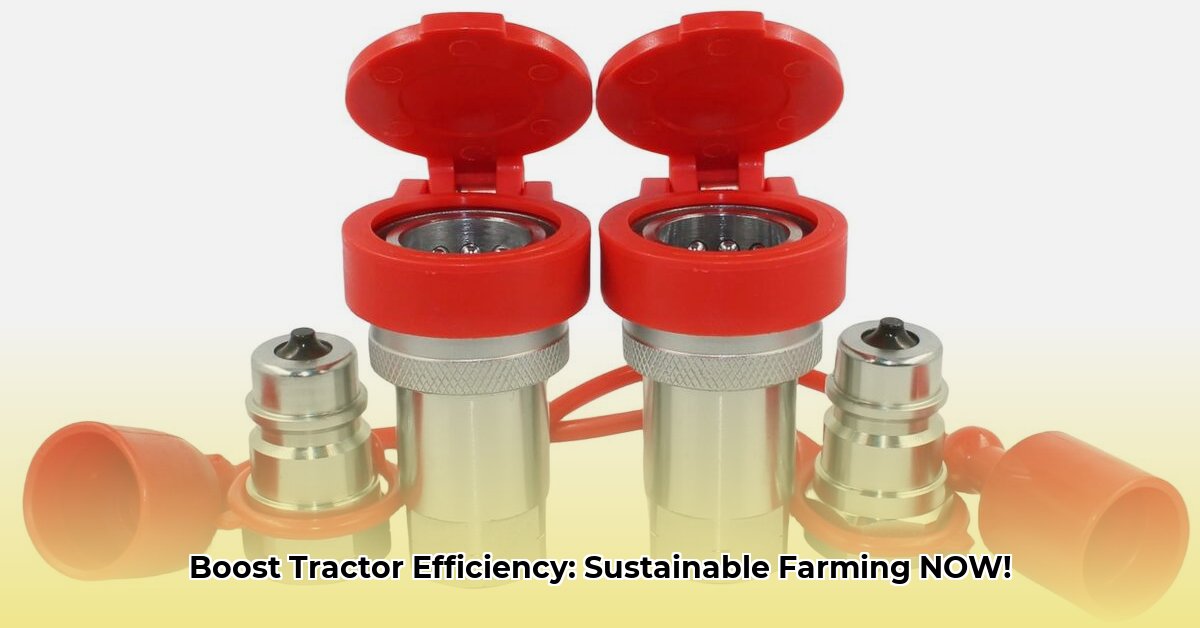
Hydraulic Quick Couplers: A Modern Farming Essential
Switching tractor implements shouldn't resemble a wrestling match. Hydraulic quick couplers significantly reduce downtime, saving you valuable time, fuel, and money. This comprehensive guide explains how these tools function, the various types available, and how to choose the best option for your farm. We'll demonstrate how quick couplers contribute to sustainable agriculture by minimizing fuel consumption, reducing soil compaction, and boosting overall profitability. We'll explore the latest technologies and calculate the potential return on investment (ROI). For more on tractor hydraulics, see this helpful resource on tractor hydraulic valves.
Understanding Hydraulic Quick Couplers
Hydraulic quick couplers are specialized connectors enabling the swift attachment and detachment of hydraulic implements to your tractor. This translates to less time wrestling with hoses and more time actively working the fields. This seemingly simple upgrade dramatically enhances workflow and efficiency, leading to cost savings and a minimized environmental footprint. Isn't reducing wasted time and fuel a worthwhile goal for any farmer?
Types of Hydraulic Couplers: A Detailed Comparison
Several coupler types exist, each suited to specific tasks and tractor configurations. The key differences include:
Single-Acting Couplers: These simpler couplers control a single hydraulic function (e.g., extending a tool). They are often a cost-effective solution for less complex implements.
Double-Acting Couplers: More versatile, controlling two hydraulic functions (hydraulic fluid flow and return). This makes them suitable for a wider range of implements with more intricate movement requirements.
Size and Flow Rate: Couplers come in various sizes, directly affecting the hydraulic fluid flow rate. Matching the coupler's flow rate to the implement's needs is critical. Using an undersized coupler leads to underpowered implements, while an oversized one is wasteful and more expensive.
| Coupler Type | Description | Pros | Cons |
|---|---|---|---|
| Single-Acting Coupler | Controls one hydraulic function | Simpler, less expensive, easier to maintain | Limited functionality; suitable for simple tools only |
| Double-Acting Coupler | Controls two hydraulic functions (flow and return) | More versatile; compatible with a wider range of tools | More complex, potentially more expensive |
| Various Sizes/Flow Rates | Different sizes for various flow rates and implement needs | Optimal performance for various implements | Requires careful selection and matching |
Choosing the right coupler hinges on the implements you use and their hydraulic demands. Consult your tractor's manual and implement specifications for compatibility.
Sustainability Advantages: The Environmental and Economic Impact
The benefits of quick couplers extend beyond time savings. They are integral to sustainable farming:
Fuel Efficiency: Reduced implement-switching time minimizes engine idling, resulting in considerable fuel savings. This lowers operating costs and reduces your farm's carbon footprint. Does a 15% fuel reduction sound appealing?
Reduced Soil Compaction: Faster changes minimize time spent in one spot, reducing soil compaction. Healthy soil is crucial for sustainable agriculture, and reduced compaction maintains soil structure and fertility. Studies show that less compaction leads to improved crop yields.
Improved Efficiency: Quicker tool changes and less downtime translate to increased work output. This boosts efficiency, lowers labor costs, and maximizes overall productivity. Imagine completing a week's work in just five days!
Precision Agriculture Compatibility: Some systems integrate with precision agriculture technologies, enabling data collection on implement use and workflow optimization.
Installation and Maintenance: A Practical Guide
Installing and maintaining quick couplers is straightforward but requires safety precautions.
Safety First: Always disconnect the tractor's hydraulic power and ensure zero pressure remains in the system. Consult your tractor's manual for proper shutdown procedures.
Clean Connections: Remove dirt or debris from the tractor and implement's connection points. Clean connections prevent leaks and ensure proper sealing.
Coupler Attachment: Connect the couplers precisely, following the manufacturer's instructions. Observe any alignment requirements.
Inspection: Check all connections for leaks or loose fittings. Tighten any loose fittings as necessary.
System Test: Before full operation, gently test the system to confirm proper hydraulic function.
Regular maintenance is crucial for coupler longevity and efficiency. Clean and lubricate components periodically, and inspect for wear or damage. Replace worn parts immediately to avoid problems and maintain safety.
Smart Coupler Technology: Data-Driven Efficiency
The evolution of quick coupler technology is ongoing. Smart couplers incorporate sensors monitoring pressure, flow rate, and temperature. This real-time data provides crucial insights into hydraulic system management and implement usage optimization. Some experts predict integration with farm management software for even greater efficiency.
Cost and Return on Investment (ROI): A Calculated Advantage
The initial cost of hydraulic quick couplers may seem substantial, but the potential ROI is significant. Savings from fuel, labor, and reduced downtime rapidly offset the initial cost. Calculating ROI based on your farm's operating hours, fuel costs, and labor rates will determine if quick couplers are a sound investment for your operation. Several online resources offer agricultural equipment ROI calculators.
Selecting the Right Coupler: A Decision Framework
Choosing the best coupler involves several factors:
Implement Compatibility: Ensure compatibility with all your implements.
Flow Rate Requirements: Select a coupler with sufficient flow rate for your most demanding tools.
Budget: Prioritize high-quality couplers from reputable manufacturers; a low-cost option often leads to increased maintenance.
Ease of Maintenance: Consider maintenance needs. User-friendly designs minimize problems.
Consulting with agricultural equipment professionals and researching brands and models provides valuable support. Reviews and specifications comparisons help you make an informed decision.
Future Trends: Innovation on the Horizon
Ongoing research and development continuously enhance quick coupler technology. Expected future innovations include:
Automation: Automated coupling systems will likely become more prevalent, reducing manual intervention and injury risk.
Materials Science: Improved materials will result in more durable, long-lasting couplers, minimizing replacements and maintenance.
Precision Agriculture Integration: Seamless integration with precision agriculture systems will further enhance efficiency.
In conclusion, hydraulic quick couplers are more than just a convenient upgrade; they are a vital tool for modern sustainable farming. They offer significant improvements in efficiency, cost savings, and environmental responsibility. By carefully choosing the appropriate system and maintaining it diligently, farmers can unlock the full potential of these versatile devices, boosting productivity and building a more sustainable agricultural future.